|
|
|
Sort Order |
|
|
|
Items / Page
|
|
|
|
|
|
|
| Srl | Item |
| 1 |
ID:
152277
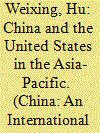

|
|
|
|
|
| Summary/Abstract |
The relationship between China and the United States is one between a rising power and an established power. Whether China is a revisionist power or a status quo power depends on how China and the United States get on with one another in the Asia-Pacific region. The US pivot to Asia and China’s rapid rise has created new dynamics for China–US relations in the region. A changing China–US relationship is also reshaping the strategic landscapes in the Asia-Pacific. US policy towards China has oscillated between containment and engagement since the end of the Cold War. In recent years, this policy has increasingly focused on the “engage but hedge” logic. The Obama administration’s pivot to Asia has rebalanced the focus of the “engage but hedge” policy and put more emphasis on political, economic and security competition with China in the Asia-Pacific region. Despite Xi Jinping’s proposal for a “new model of major power relations” between China and the United States, both countries are actually entering into a “new normal” type of power rivalry in the Asia-Pacific region.
|
|
|
|
|
|
|
|
|
|
|
|
|
|
|
|
| 2 |
ID:
161973


|
|
|
|
|
| Summary/Abstract |
How China’s “new normal” affects the conduct of monetary policy deserves a careful study. The enormous task of economic restructuring, amid conflicting goals, has certainly introduced a new set of challenges to macroeconomic management. This article provides empirical evidence to show that the conduct of China’s monetary policy has indeed changed and become less predictable since 2013. While supply-side structural adjustments significantly decrease local governments’ appetite for investment and create slacks in aggregate demand, macroeconomic policymakers feel compelled to ease off deleveraging pressures when the adjustment pains are considered unbearable. The monetary authority also faces the policy trilemma when the internationalisation of the renminbi requires a strong currency and free flow of capital. Furthermore, the dual-track interest rate system creates speculative capital movements between bank deposits and the money market which complicates the transmission mechanism of monetary policy. Inconsistencies are thus created, and reversals of policy direction are frequently observed.
|
|
|
|
|
|
|
|
|
|
|
|
|
|
|
|
| 3 |
ID:
170339
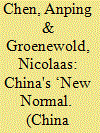

|
|
|
|
|
| Summary/Abstract |
China's ‘New Normal’ has been much discussed in recent years. An important aspect of the New Normal is the growth slowdown from levels of around 10% per annum to a more modest 6 or 7%. Not surprisingly, there has been widespread discussion of whether the slowdown is permanent or not and, in either case, what the sources of the slowdown are. However, much of this discussion has been based on informal analysis of the data rather than formal econometric results. We make a move in the direction of formal empirical analysis of this issue by estimating and simulating a vector autoregressive (VAR) model which distinguishes between demand, supply and foreign shocks as possible drivers of changes in economic growth. We analyse both two-variable (growth and inflation) and three-variable (foreign growth, domestic growth and inflation) VAR models and identify demand, supply and foreign shocks, using a modification of the Blanchard-Quah identification procedure. In the two-variable model we identify two shocks (demand and supply) and find that the slowdown since the GFC has been mainly supply-driven. This conclusion is not changed when a foreign growth variable is added to the model and a foreign shock is allowed for – we find that demand continues to be of relatively little importance, that the foreign shock also makes little contribution to explaining the long-run growth decline in China which continues to be driven by long-term supply factors. This conclusion is robust to a number of alternative formulations of the model. Thus, the growth slowdown may, indeed, be characterised as the ‘New Normal’.
|
|
|
|
|
|
|
|
|
|
|
|
|
|
|
|
| 4 |
ID:
179253
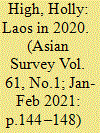

|
|
|
|
|
| Summary/Abstract |
In 2020, Laos successfully contained the spread of COVID-19, with very few cases and no deaths. The key elements of the COVID-19 response reflect not only public health advice but also the core values of the political culture promoted by the ruling Lao People’s Revolutionary Party. These include unity, solidarity, struggle, respect for science, guidance by a strong center, and the extension of the state into everyday life in the form of designated roles, committees, and organizations. These significantly shaped the social fabric drawn on in the COVID-19 response. This success, then, can be read as a reaping of some of the benefits of this political culture. More ominously, the global pandemic exacerbated Lao PDR’s public debt crisis. Born of years of government backing of megaprojects such as hydropower, this debt is the dark harvest of the LPRP’s reign.
|
|
|
|
|
|
|
|
|
|
|
|
|
|
|
|
| 5 |
ID:
164205


|
|
|
|
|
| Summary/Abstract |
THE INTERNATIONAL SITUATION is changing so rapidly and spontaneously that there is every reason to speak about heavy turbulence in the global economy and international politics. The Latin and Caribbean America (LCA) region is not immune from these general disturbances. It is difficult to conceptualize what is going on.
|
|
|
|
|
|
|
|
|
|
|
|
|
|
|
|
| 6 |
ID:
177157
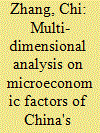

|
|
|
|
|
| Summary/Abstract |
Reducing energy intensity is the key point to solve the contradiction among economic development, energy constraints and environmental pressure in China. Considering microeconomic factors, this paper extends decomposition and attribution models, and analyses the drivers of China's industrial aggregate energy intensity (AEI) at the regional/sectoral level. The results show that AEI decreased by 49% during 2000–2017. At the regional level, most provinces presented negative contribution on regional energy intensity effect. The AEI decline was attributed to the drop of greatest negative effect of R&D efficiency in Liaoning. The increase in investment intensity and R&D intensity lead to an increase in AEI, largely owning to Shandong and Liaoning, respectively. At the sectoral level, the AEI decline can be mainly explained by the inhibition effect of energy intensity and R&D efficiency. However, this negative contribution was greatly offset by the R&D intensity effect. The investment intensity showed a positive impact in AEI increase, and smelting and pressing of ferrous metals sector was the main contributor. Regional and sectoral investment structure effect shifted from increasing to decreasing AEI over the study period. Based on the results, targeted policy recommendations are proposed to further decrease the China's industrial AEI in the 14th FYP period.
|
|
|
|
|
|
|
|
|
|
|
|
|
|
|
|
| 7 |
ID:
193785


|
|
|
| 8 |
ID:
163492
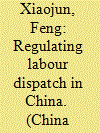

|
|
|
|
|
| Summary/Abstract |
This article suggests cautious optimism toward the prevailing Polanyian countermovement discourse by providing a timely and comprehensive examination of the enforcement of the labour dispatch regulation in China. Since the enactment of the regulation, some enterprises have narrowed the remuneration gap between agency workers and formal employees, while others have retained a large gap in overtime pay, bonuses, and welfare benefits between these two groups of workers. The regulation has reduced the number of agency workers, but has invoked the abuse of the more precarious ‘outsourced’ workers as well. The regulation has had little effect on limiting the use of agency labour to temporary, auxiliary, or substitute positions, raising the requirements of engaging in the labour dispatch business, or stabilizing the employment of agency workers. This article contributes to the extant literature on regulatory enforcement by examining the effects of non-standard employment regulation, highlighting the variance of labour law compliance among enterprises with different types of ownership, and demonstrating how China’s ongoing transformation from a planned to a market economy since the 1980s and from high growth to a new normal since 2010 has fundamentally constrained the full implementation of its labour protection regulation.
|
|
|
|
|
|
|
|
|
|
|
|
|
|
|
|
| 9 |
ID:
137911
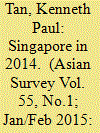

|
|
|
|
|
| Summary/Abstract |
In the ‘‘new normal’’ following the 2011 general election, Singapore seems poised for further development toward liberal democracy. However, the ruling People’s Action Party is attempting to reinvent itself and regain its hegemonic position, which requires finding credible solutions for very challenging problems to do with policy, communication, and public image.
|
|
|
|
|
|
|
|
|
|
|
|
|
|
|
|
| 10 |
ID:
145441
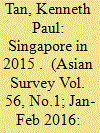

|
|
|
|
|
| Summary/Abstract |
In 2015, Singaporeans voted in parliamentary elections. The incumbent People’s Action Party won a landslide victory, in contrast with its performance in the 2011 elections, which had been the worst since Singapore gained independence. The party successfully reinvented itself as a more left-leaning and responsive party in government. Its public image improved by its association with Lee Kuan Yew, who passed away in this jubilee year.
|
|
|
|
|
|
|
|
|
|
|
|
|
|
|
|
|
|
|
|
|